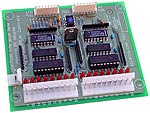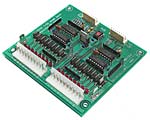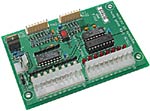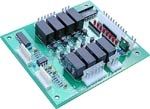Digital I/O expansion boards increase the number of I/O points. These boards connect to the controller via a plug-in cable. Several expansion boards can be
daisy chained, up to a maximum of 32 outputs and 32 inputs (or 32 bidirectional I/O points). When you connect expansion boards the controller detects them
automatically and the programming software adjusts itself. There is no software configuration required.
These boards are compatible with the CC18, MMi203A, MS121 and SL100
controllers
| XBIO16 |
MBIO16 |
FP16 |
XIRO16 |
HIO16 |
 |
 |
 |
 |
 |
| This board gives you 16 bidirectional I/O points that can each be used as in input or an output. |
Similar to XBIO, but with outputs rated at up to 2A. 16 bidirectional I/O points that can each be used as in input or an output. |
Add 8 inputs and 8 outputs. Inputs are NPN/PNP selectable. Outputs sink up to 400mA. |
8 5A/240V relays and 8 digital inputs, this is the ideal expansion board where medium duty relay outputs are required. |
Eight relays each rated 20A at 240V with an 80A inrush rating. Alternatively they are UL rated for 1HP. The board also has eight opto-isolated inputs capable of working at 24V through 240V AC or DC. |
| >>more info |
>>more info |
>>more info |
>>more info |
>>more info |
Expansion board comparison chart
|
XBIO16 |
MBIO16 |
FP16 |
XIRO16 |
HIO16 |
| Digital inputs |
16 bidirectional I/O |
16 bidirectional I/O |
8 NPN/PNP |
8 NPN |
8 Isolated |
| Digital outputs |
8 Transistor |
8 Relays |
8 Relays |
| Contact configuration |
N/A |
N/A |
N/A |
6xSPST, 2xSPDT |
All SPST |
| Output current |
400mA DC |
1.5A DC |
400mA DC |
5A AC/DC
(resistive load) |
20A AC/DC
1HP motor load |
| Output voltage rating |
24V DC |
24V DC |
24V DC |
240VAC/DC |
240VAC/DC |
| I/O indicator LEDs |
Yes |
Yes |
Yes |
On inputs |
No |
| Max expansion capacity |
2 boards
(32 I/O) |
2 boards
(32 I/O) |
4 boards
(32 In, 32 Out) |
4 boards
(32 In, 32 Out) |
4 boards
(32 In, 32 Out) |
| Price, Qty 1 |
$89 |
$104 |
$79 |
$119 |
$149 |
An NPN input is 'ON' when the input pin is connected to circuit common either by a switch (or piece of wire) or by an industrial NPN sensor.
All inputs on all SPLat controllers have inbuilt contact debounce of 8-16mS. That means in most cases you can just hook them up to a switch or sensor and
not have to worry about contact bounce. There are also non-debounced input instructions and latched input modes that will capture an OFF to ON transition. It
is also possible to read 8 inputs at a time across any 8 contiguous inputs.
These boards use an expansion scheme called XPice. There is a limit on how many expansion 'nodes' can be used in this scheme.
At the present time the limit is 64 nodes.One node generally corresponds to 1 input or 1 output. On the XBIO16 each bidirectional I/O point
uses up 2 'nodes'. So while the XBIO16 is very convenient, it doesn't extract the maximum possible expansion capacity.
An alternative programming technique exists that works around this limit.
The MBIO16 and XBIO16 feature bidirectional I/O ("BIO"), a SPLat innovation first introduced with our OEM36 many years ago.
A BIO pin can be used as an input or as an output, giving you the maximum flexibility in applying the resources of the controller.
Which mode it operates in is down to the programming, which is very simple. There are no direction registers or configuration procedures,
simply use it as one or the other and it just happens.
As an input the BIO pin is a standard NPN input with all the programming flexibility of any other input. As an output is is just like any other output.
The XBIO16 has 400mA output capability, the MBIO16 has up to 2A.
An NPN input is 'ON' when the input pin is connected to circuit common either by a switch (or piece of wire) or by an industrial NPN sensor.
A PNP input is 'ON' when the input pin is connected to + supply either by a switch (or piece of wire) or by an industrial PNP sensor.
The inputs on the FP16 can be set by means of a single jumper work in NPN or in PNP mode.
All inputs on all SPLat controllers have inbuilt contact debounce of 8-16mS. That means in most cases you can just hook them up to a switch
or sensor and not have to worry about contact bounce. There are also non-debounced input instructions and latched input modes that will capture
an OFF to ON transition. It is also possible to read 8 inputs at a time across any 8 contiguous inputs.
An NPN input is 'ON' when the input pin is connected to circuit common either by a switch (or piece of wire) or by an industrial NPN sensor.
All inputs on all SPLat controllers have inbuilt contact debounce of 8-16mS. That means in most cases you can just hook them up to a switch or
sensor and not have to worry about contact bounce. There are also non-debounced input instructions and latched input modes that will capture an OFF
to ON transition. It is also possible to read 8 inputs at a time across any 8 contiguous inputs.
The isolated inputs on the HIO16 use optocouplers. They are designed so they can be activated by any voltage between 24V and 240V, AC or DC.
There are 2 groups of 4 inputs, with a common terminal for each group. With DC activation the common terminal must be negative, meaning the inputs in
this mode are PNP type.. You have to supply an activation voltage externally.





